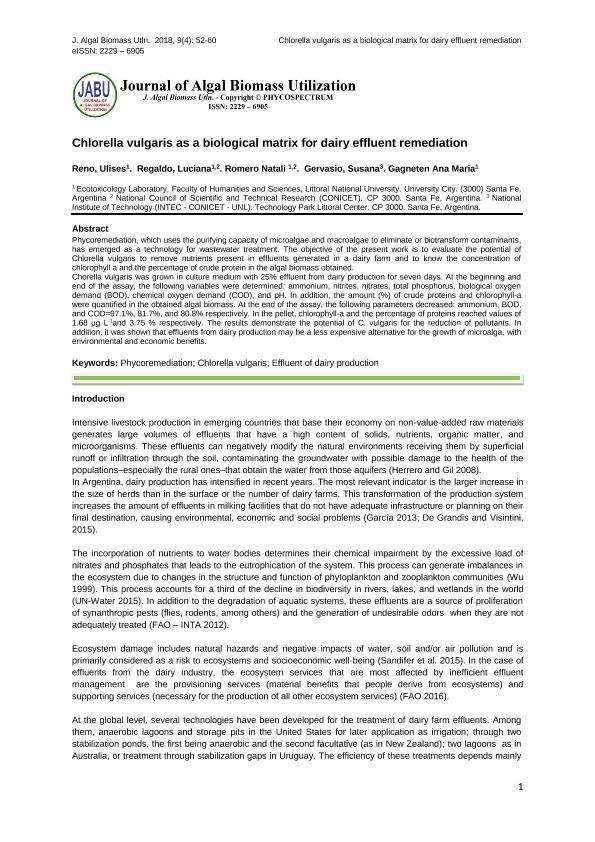Artículo
Chlorella vulgaris as a biological matrix for dairy effluent remediation
Reno, Ulises ; Regaldo, Luciana María
; Regaldo, Luciana María ; Romero, Natalí
; Romero, Natalí ; Gervasio, Susana Graciela
; Gervasio, Susana Graciela ; Gagneten, Ana María
; Gagneten, Ana María
 ; Regaldo, Luciana María
; Regaldo, Luciana María ; Romero, Natalí
; Romero, Natalí ; Gervasio, Susana Graciela
; Gervasio, Susana Graciela ; Gagneten, Ana María
; Gagneten, Ana María
Fecha de publicación:
03/2019
Editorial:
Phycospectrum
Revista:
Journal of Algal Biomass Utilization
ISSN:
2229-6905
Idioma:
Inglés
Tipo de recurso:
Artículo publicado
Clasificación temática:
Resumen
Phycoremediation, which uses the purifying capacity of microalgae and macroalgae to eliminate or biotransform contaminants, has emerged as a technology for wastewater treatment. The objective of the present work is to evaluate the potential of Chlorella vulgaris to remove nutrients present in effluents generated in a dairy farm and to know the concentration of chlorophyll a and the percentage of crude protein in the algal biomass obtained.Chorella vulgaris was grown in culture medium with 25% effluent from dairy production for seven days. At the beginning and end of the assay, the following variables were determined: ammonium, nitrites, nitrates, total phosphorus, biological oxygen demand (BOD), chemical oxygen demand (COD), and pH. In addition, the amount (%) of crude proteins and chlorophyll-a were quantified in the obtained algal biomass. At the end of the assay, the following parameters decreased: ammonium, BOD, and COD=97.1%, 81.7%, and 80.8% respectively. In the pellet, chlorophyll-a and the percentage of proteins reached values of 1.68 μg L-1and 3.75 % respectively. The results demonstrate the potential of C. vulgaris for the reduction of pollutants. In addition, it was shown that effluents from dairy production may be a less expensive alternative for the growth of microalga, with environmental and economic benefits.
Palabras clave:
PHYOREMEDIATION
,
CHLORELLA VULGARIS
,
EFFLUENT OF DAIRY PRODUCTION
Archivos asociados
Licencia
Identificadores
Colecciones
Articulos(CCT - SANTA FE)
Articulos de CTRO.CIENTIFICO TECNOL.CONICET - SANTA FE
Articulos de CTRO.CIENTIFICO TECNOL.CONICET - SANTA FE
Articulos(INTEC)
Articulos de INST.DE DES.TECNOL.PARA LA IND.QUIMICA (I)
Articulos de INST.DE DES.TECNOL.PARA LA IND.QUIMICA (I)
Citación
Reno, Ulises; Regaldo, Luciana María; Romero, Natalí; Gervasio, Susana Graciela; Gagneten, Ana María; Chlorella vulgaris as a biological matrix for dairy effluent remediation; Phycospectrum; Journal of Algal Biomass Utilization; 9; 3-2019; 52-60
Compartir



